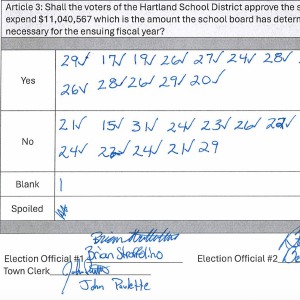Housing project on track to add 42 apartments in White River Junction
| Published: 10-05-2022 1:10 AM |
WHITE RIVER JUNCTION — A new 42-unit affordable housing project is slated for a lot right near Lyman Bridge, which carries traffic across the Connecticut River from Vermont to West Lebanon.
The Riverwalk project, which will occupy the corner of Maple Street and Prospect Street, is a joint effort between DEW Construction and The Braverman Co. (DEW-Braverman). Once construction is complete, DEW-Braverman will transfer ownership of the development to Twin Pines Housing Trust and Evernorth, two nonprofit housing development organizations.
The units are aimed at helping to address the region’s housing crisis. According to Beth Long, Twin Pines Housing’s CFO and deputy director, the vacancy rate of rental housing units in the Upper Valley is considered to be under 1%.
“It’s very hard for people to find rentals right now,” she said.
The project targets two undeveloped lots, totaling 0.86 acres. The 42-unit, multi-family development would include 10 studios, four three-bedroom, 20 two-bedroom, and eight one-bedroom apartments, and the residential floor area would total 43,297 square feet.
The development would also include 26 “tuck-away” parking spaces within a garage, 30 surface parking spaces, a community lounge and tenant storage.
The property is owned by DEW-Prospect Street, LLC — an affiliate of DEW Properties — and the project is a part of DEW’s ongoing Prospect Street redevelopment project, which also includes two completed structures: a four-story building with state offices and a two-story commercial building that hosts a hair salon.
The Riverwalk Housing Project would offer affordable housing to a range of incomes. Depending on the number of people living in a unit, residents with yearly incomes varying anywhere from about $30,000 upward toward $90,000 could be eligible to rent, said Andrew Winter, executive director of Twin Pines Housing, in a phone interview last week.
Article continues after...
Yesterday's Most Read Articles
 Upper Valley winter shelters kept dozens warm and dry
Upper Valley winter shelters kept dozens warm and dry
 Former principal of South Royalton School released from prison
Former principal of South Royalton School released from prison
 Owner of Friesian horse facility ordered to pay care costs for seized animals
Owner of Friesian horse facility ordered to pay care costs for seized animals
z“The idea with this project is that it’s truly mixed-income,” Winter said. “We want housing that’s going to be affordable for people.”
Eight of the Riverwalk units will also aim to serve households experiencing or at risk of homelessness.
The project is moving along, having received support from three municipal boards last month. With adequate funding, construction might begin later this year, expected to finish by December 2023, according to materials provided to the Hartford Selectboard.
During its Sept. 6 meeting, the Hartford Selectboard approved a motion to support the submission of the grant application from the Vermont Community Development Program for $400,000, or about 2.5% of the project’s expenses, which total around $15 million.
“This project is a little different in that we’re going to acquire (the grant) after it’s built,” Long, Twin Pines’ CFO, said during the meeting earlier last month. “In order to commit to do that, we need to secure all the funding ahead of time.”
Block grant money through the program is federally funded, but the grant application must come from a municipality, Lori Hirshfield, Hartford’s planning and development director, said during the Sept. 6 Selectboard meeting. The money from the grant also has to be put toward low- to moderate-income households, and a public hearing must be held to discuss the grant.
“Every layer of our funding is important, and these $400,000 are important,” Long said.
Other sources of funding for the project include the Vermont Housing and Conservation Board, Home Investment Partnerships Program, low-income housing tax credits, bank financing and the Upper Valley Loan Fund.
Five members of the public were present for this meeting agenda item, and public comments during the hearing included support for the project given the need for housing in the area.
Selectboard Vice Chairman Dan Fraser asked about plans for the building’s environmental sustainability and greenspace initiatives.
“With the new energy bill that’s coming from the federal government, I’m encouraged to see that you have heat pumps for heating and cooling, but I also wonder whether there’s funding for powerwall types of things that store electricity,” he said. “We can look at that now and see if there are grants available to do that.”
Evernorth senior developer, Ben Sturtz, said the project is slated to be solar-ready.
“There’s a really good chance the building will have solar panels,” he said. “We know we’ll have some (electric vehicle) charging stations,” he added.
He also brought up special considerations that will need to be made since part of the site is in a designated flood hazard area right next to the Connecticut River.
“In terms of the site itself, there’s not a lot to do the kind of green space we typically would do at another project,” he said. “A lot of it’s devoted to stormwater detention at this particular site.”
Since the Selectboard’s approval of the grant application, the applicants have also received municipal land-use approvals from the Hartford Zoning Board of Adjustment and Planning Commission. The developers plan to file for a building permit later this fall, Winter said.
The VCDP grant application has also since been submitted, and it is expected to be heard before the Vermont Community Development Board in November, Hirshfield said.
“This project won’t actually be built for probably another year or year and a half,” Long said. Residents are expected to move in around spring of 2024, if all goes to plan.
Rose Terami can be contacted at rosoterami@gmail.com.

 Hartland voters successfully petition for school budget revote
Hartland voters successfully petition for school budget revote 
